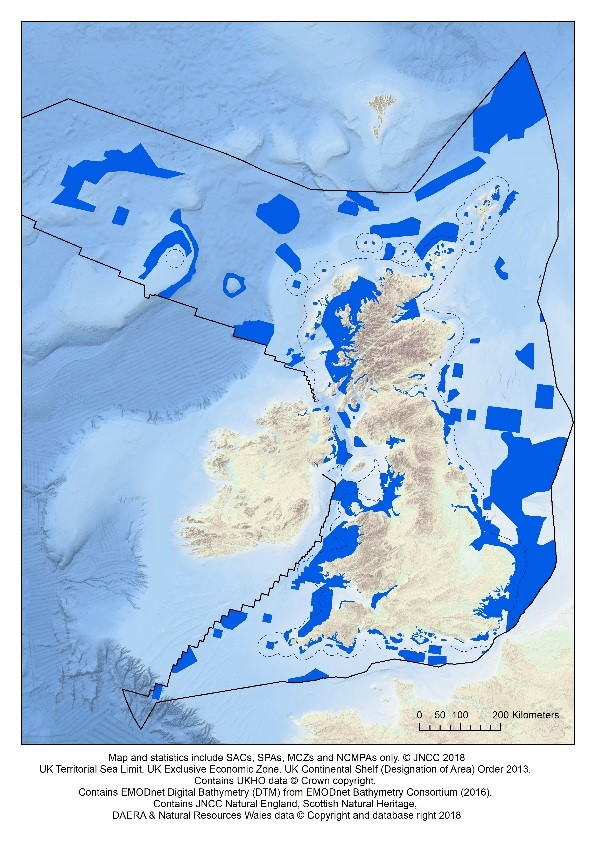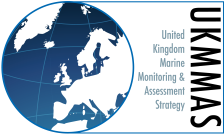Progress towards an ecologically-coherent and well-managed network of Marine Protected Areas in the UK
The Marine Protected Area (MPA) network in the UK protects a wide range of marine life, with sites covering nearly a quarter of UK waters and representing the range of habitats and species found across the UK marine environment.
Background
The UK’s marine environment is home to some of the most biologically diverse habitats and species in Europe. MPAs are one of the tools that can help protect the marine environment whilst enabling sustainable use to continue. The UK Joint Administrations Statement (2012) aspires to have an ecologically-coherent, well-managed network which makes an effective contribution to international MPA networks.
The UK Administrations follow several key principles in their development of an ecologically-coherent and well-managed MPA network. These principles were derived from :
- Features: the network should represent the range of habitats and species for which MPAs are considered appropriate
- Representivity: the network should include areas that best represent the range of habitats and species
- Connectivity: the network should comprise MPAs that are well-distributed and take into account linkages between marine systems
- Resilience: the network should include more than one example of a feature in individual MPAs and ensure they are of sufficient size to deliver conservation benefits
- Management: the network should ensure the protection of marine habitats and species for which an MPA has been identified
Progress with developing the UK MPA network
Defra, the Welsh Government, the Scottish Government and the Department of Agriculture, Environment and Rural Affairs Northern Ireland have recently reported on progress on the MPA network. As of November 2018, there are 314 designated MPAs protecting 24% of UK waters compared to 217 sites covering 8% of UK waters in 2012. The map in Figure 1 shows the UK coverage.

Figure 1: Map showing the extent of the UK MPA network as of November 2018
Features, Representivity and Resilience
- MPA selection processes in the UK have sought to protect examples of the range of marine life. These features include representative habitat types such as subtidal sedimentary communities, as well as more unusual seabed habitat types such as deep-sea sponge aggregations – a feature considered to be under threat and subject to decline across the North-east Atlantic.
- By example, all 23 broad-scale habitat types occurring in English waters are protected within MPAs and 22 of these are protected more than once across all regions in which the feature occurs (see Carr and others, 2016). In Scotland, the MPA network affords protection to all known sub-types of habitats and species across their geographic range (Cunningham and others, 2015). In Northern Ireland, all but one of the 24 broad-scale habitats are represented (protected) at least twice (JNCC, 2018). In Wales, the majority of habitats and species are represented and where possible replicated, and the network is well connected to provide resilience.
Connectivity
- Scientific understanding of the ability of marine animals and plants to disperse, and over what distance, is limited. The distance between individual MPAs has been used as part of country-level assessments within the UK and as part of North-east Atlantic wide assessments under OSPAR as a proxy for MPA network connectivity. According to the latest assessment conducted under OSPAR (OSPAR Commission, 2016), the UK component of the OSPAR MPA network is considered to be well-connected.
Management
Management measures are being put in place to protect our marine environment. All sites are protected through the licensing and planning process from the point they are consulted on. A risk-based approach to deliver effective management of activities in MPAs has been developed by regulators. Examples of fisheries protection measures include bans on the use of bottom-towed gear and seasonal closures to protect nursery grounds. Fisheries measures for offshore sites are yet to be agreed. In Wales, the MPA Management Steering Group (which comprises representatives of the main management authorities in Wales) has recently agreed and published an MPA Network Management Framework and Action Plan for Wales. These set out MPA management arrangements in Wales and provide a focus on the priority actions to further improve the management and condition of the network of MPAs in Wales.
Conclusion
The proportion of UK waters within MPAs has significantly increased between 2012 and 2018. MPAs across the UK marine area will contribute towards achieving and maintaining Good Environmental Status, in particular Descriptor 1 and Descriptor 6, over the coming years, and to an ecologically coherent and well-managed network of MPAs under the OSPAR Convention.
References
Acknowledgements
Carr H, Cornthwaithe A, Wright H, Davies J (2016) ‘Assessing progress towards an ecologically coherent MPA network in Secretary of State Waters in 2016:Results' Joint Nature Conservation Committee (viewed on 20 March 2019)
Cunningham S, Chaniotis PD, Gillham K, James B (2015) ‘Assessment of the adequacy of the Scottish MPA network for MPA search features: summary of the application of stage 5 of the MPA Selection Guidelines post consultation’ Assessing risk to Scottish MPA search features at the MPA regional scale Final report produced by the Joint Nature Conservation Committee, Scottish Natural Heritage and Marine Scotland for the Scottish Marine Protected Areas Project (viewed on 20 March 2019)
Cornthwaite A, Wright H, Cioffi R, Davies J (2018) ‘Assessing progress towards an ecologically coherent network of Marine Protected Areas in the Northern Ireland inshore region’ JNCC (viewed on 20 March 2019)
Joint Administrations Statement (2012) ‘UK Contribution to Ecologically Coherent MPA Network in the North East Atlantic’ Defra, DOE, Scottish Government, Welsh Government (viewed on 20 March 2019)
OSPAR Commission (2016) ‘2016 Status Report on the OSPAR Network of Marine Protected Areas’ Biodiversity and Ecosystems Series (viewed on 20 March 2019)
